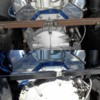Pull up a chair, RR- this is a complicated subject! If you've tried everything mentioned here and nothing improves the situation up front, how are you checking front camber?
Also, when you get underneath is there any evidence of a collision? The entire front clip will bend up, down or sideways in not-too-hard accidents, which then causes alignment problems- especially if such damage was fixed by non-Pantera specialists. Wilkinson has a factory alignment jig- the only one I know of in the U.S.
Rear Camber is adjusted by threading the lower a-arm inner clevis-mounts in/out to reangle the lower a-arms (for both toe-in and camber), but 42 years of pounding on our poor roads usually collapses the whole rear subframe assembly to some degree. Up to- 4 degrees of camber is often see; such high amounts will eat the inner edges of expensive rear tires. So stock rear adjustment is not usually very effective.
Many owners buy an 'adjustable' rear bay-brace- I recommend Hall's straight-steel bar with the extra long ends. In practice, you jack up the rear wheels and 'firmly' preload the giant adjusting screw, then lower and drive for a few days. Be sure the jam-nuts are tight and do NOT try to correct everything all at once! The camber you get is not important at this stage. After a week or so of 'normal' driving, jack the rear wheels up again and take another 1/2 turn on the adjuster. Over the course of a month or so- if you're patient AND lucky, you can usually tease the rear assembly back to zero camber. If you're impatient and try for an all-at-once adjustment using the bay brace screw, you will buckle the rear quarter panels. Bodywork is very expensive!
Another way is 'adjustable' upper rear a-arms that use large heim joints in place of stock ball joints. The arms can compensate for subframe collapse. If you go this way, please do NOT drill out the tapered hole in the rear carrier for a bolt! There are 7 degree tapered studs cheaply available from Speedway Motors but are not always included in aftermarket a-arm kits for some unknown reason. Speedway also sells economical heim-joint seals to keep road-slop and water out of the unprotected heims. And IMHO, such cars STILL need a pre-loadable bay-brace, or the car's subframe collapse will continue indefinitely.
There are many designs of adjustable bay braces but most simply hang on the flimsy body-tabs provided for the stock bar. Thus 100% of big-tire cornering loads go through those skinny tabs with slotted oversized holes. The long ends of the steel Hall bar (and a very few others) slide far inside the welded mounts, transferring loads to the upper shock absorbers & their weldments which are on the other side of those wimpy tabs. So with the Hall bar, the attach bolts simply keep the bay-brace from popping out as the rear assembly flexes in turns. They do not have to take cornering loads.


